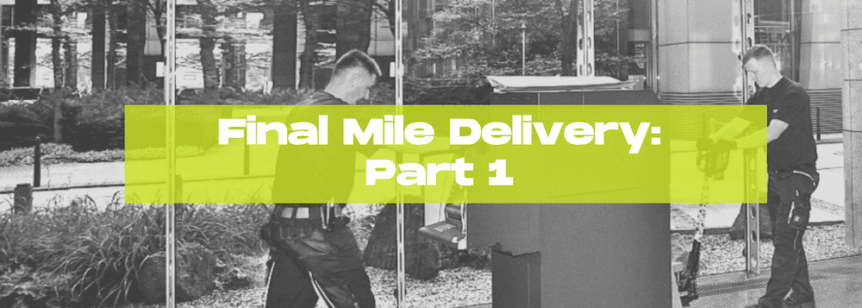Every stage of the logistics process is crucial, but there is no point that’s a higher priority than that of the final mile delivery stage. Proper handling of a shipment from origin to destination is important, but after it gets to the destination, there’s still work to be done.
At Pegasus, we understand this and are in the business of making you look good.
What is Final Mile, or Last Mile, Delivery?
In freight, the terms final mile and last mile are synonymous.
At Pegasus, when we think of the final mile, we think about your experience, the client experience. Not only the final destination or just the point A to point B situation but the touchpoint to your customer. Not just a loading dock to dock or warehouse scenario, but the tough delivery that occurs after that point.
ATMs being delivered into a bank or an x-ray machine being delivered up to the fourth floor of a hospital, for example. For many of our clients, we are bringing in large, heavy equipment into a sensitive environment with the risk of floors or doorways being damaged.
Why is the Last Mile Mission Critical?
The consequence of failure if the final mile goes awry is a very big deal. Much of the equipment we are transporting is expensive, whether it’s server racks, ATMs, or high-dollar medical or high-tech equipment. As you know, these products are tied to significant penalties for failure. There may be SLA penalties or revenue recognition associated with the final delivery location, risking tens of thousands to upwards of millions of dollars in financial impact to your organization.
Secondly, this will be the first impression your customers have. The final mile delivery is the only face-to-face time that your customers may have with your products that we’re delivering, so it is extremely important that we have it right, from our professionalism to on-time accuracy. We become the face of your organization, so when we’re taking that product into the delivery location, we are a direct reflection of your company. The final mile component can make or break that deal. If it goes poorly, the entire deal could be represented as poorly.
What About Before Point A? The First Mile?
One another thing to consider when we’re talking about final mile delivery is the first mile of shipment delivery. When you are procuring goods, those might be purchased from somewhere else which is not a normal dock-to-dock type situation. This might require some unique, customized pickup or handling or crating of goods that could be necessary to protect your product while it’s en route.
Let’s say your customer has bought some goods in an open container situation without proper packaging, yet they’re selling it to an international customer where there’s all sort of packaging, crating, or documentation requirements. These are a couple of examples of unique handling attributes you must into consideration on the first mile.
Tools for Managing Final Mile Delivery
The final mile can be a lot for you or your clients to tackle alone and providing the best customer experience can be difficult if you’re not working with the right partner. Even if you’re not on-site, you still want to be sure the managed delivery is up to your standards.
We want every delivery to be expertly executed, so we offer a few tools to ensure each delivery is a success.
- Site Profiles – We meet all client-defined site requirements, addressing even the most unique delivery needs. Once the delivery or pick-up location is in our system, it’s there forever. So, your experience is recorded for consistency of service, as we build off any nuances or challenges at the final mile, and proactively work with partners to ensure they are prepared for on-site arrival.
- Delivery Checklist – Our delivery experts verify that every job is completed with the utmost attention to detail. With our delivery checklists, we provide a consistently great experience by making sure every driver signs and verifies they know the expectation of the specific job.
- Photos – Clients with White Glove Delivery receive comprehensive photos of the product in its final location to show that no damage occurred during delivery.
- Standard Operating Procedures – We follow internal and field-specific operating procedures as well as customized operating procedures for our clients.

